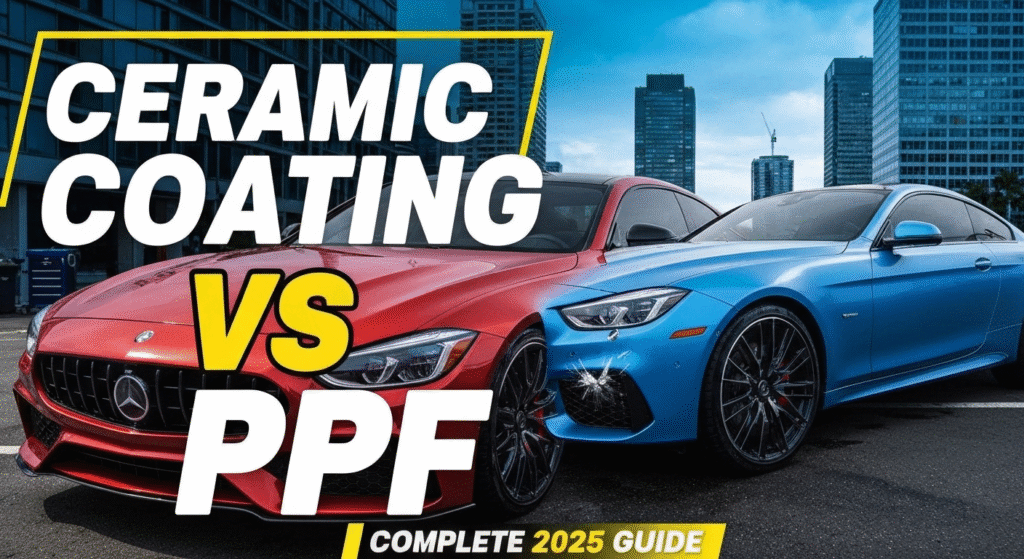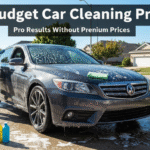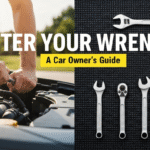Car paint protection has become essential for maintaining your vehicle’s value and appearance. Two main options dominate the market: ceramic coating and paint protection film (PPF). Both protect your car’s paint, but they work differently and serve different needs.
I’m Sharmin, and I’ve spent five years working directly with automotive detailing and paint protection systems. During this time, I’ve applied hundreds of ceramic coatings and PPF installations on vehicles ranging from daily drivers to luxury supercars. My hands-on experience has taught me which protection method works best for different situations and budgets.
This guide breaks down everything you need to know about ceramic coating versus paint protection film. You’ll learn the pros and cons of each option, understand the costs involved, and discover which protection method fits your specific needs.
What is Ceramic Coating?
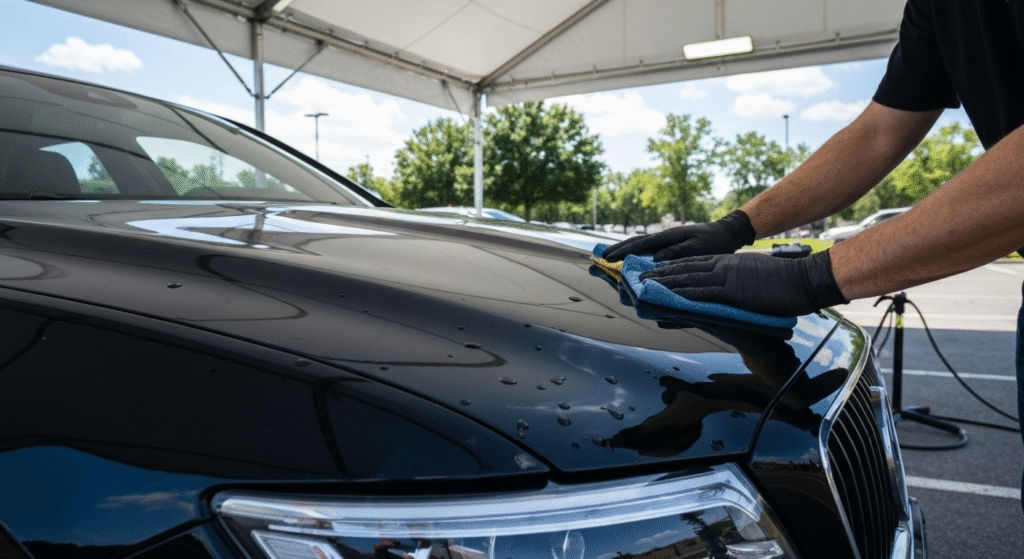
Ceramic coating creates a thin, transparent layer over your car’s paint using liquid polymer technology. When applied correctly, it chemically bonds with the paint to form a protective barrier that lasts for years.
The coating contains silicon dioxide (SiO2) and other compounds that create a hard, glass-like surface. This surface repels water, dirt, and many contaminants that would otherwise stick to your paint.
How Ceramic Coating Works
The ceramic coating process involves several steps. First, the car gets thoroughly washed and decontaminated. Next, the paint receives correction treatment to remove swirl marks and scratches. Finally, trained technicians apply the ceramic coating in thin layers using special applicators.
The coating needs 24-48 hours to fully cure and bond with the paint. During this time, the car must stay dry and protected from dust and debris.
Types of Ceramic Coating
Professional-grade ceramic coatings offer the best protection and durability. These coatings typically last 2-5 years and provide superior performance compared to consumer products.
Consumer ceramic coatings are available for DIY application. While cheaper, they don’t last as long or provide the same level of protection as professional products.
Ceramic spray coatings offer temporary protection and easy application. They last 3-6 months and work well for maintenance between professional applications.
What is Paint Protection Film (PPF)?
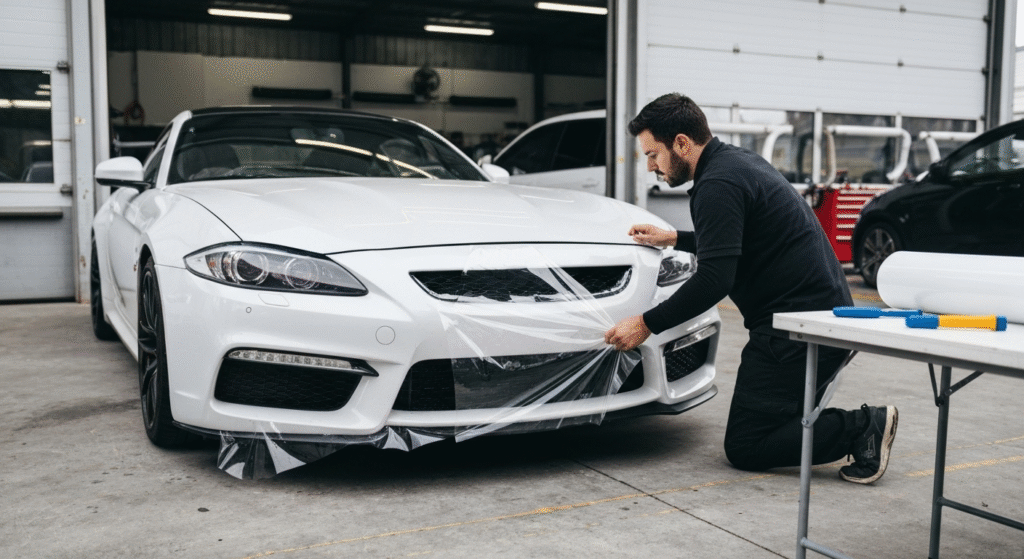
Paint protection film is a clear, thick polyurethane material that physically covers your car’s paint. Originally developed for military helicopter blades, PPF has evolved into an advanced automotive protection system.
Modern PPF is nearly invisible when properly installed. It absorbs impact from road debris, prevents scratches, and can even self-heal minor damage when exposed to heat.
How PPF Works
PPF installation requires precise cutting and fitting to each panel of your vehicle. Professional installers use computer-cut templates or hand-cut the film to ensure perfect coverage.
The film adheres to the paint using a pressure-sensitive adhesive. Unlike ceramic coating, PPF can be removed without damaging the original paint underneath.
Types of PPF
Standard PPF provides excellent protection against rock chips, scratches, and UV damage. This option works well for most vehicles and driving conditions.
Self-healing PPF contains special polymers that allow minor scratches and swirl marks to disappear when exposed to heat. A hair dryer or warm sunlight activates the healing process.
Colored PPF comes in various tints and finishes, including matte and satin options. This allows you to change your car’s appearance while adding protection.
Ceramic Coating vs PPF: Detailed Comparison
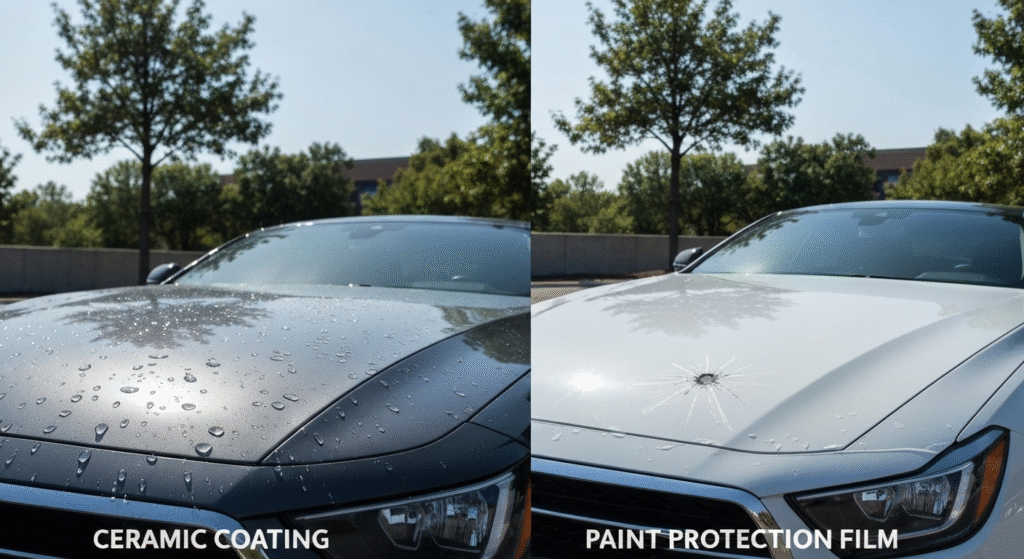
| Feature | Ceramic Coating | Paint Protection Film |
|---|---|---|
| Protection Level | Chemical resistance, UV protection | Physical impact protection |
| Durability | 2-5 years | 5-10 years |
| Cost | $800-2,500 | $2,000-8,000 |
| Maintenance | Low | Very low |
| Appearance | Enhanced gloss | Natural paint look |
| Installation Time | 1-2 days | 2-5 days |
Protection Capabilities
Ceramic coating excels at protecting against environmental contaminants. It prevents water spots, bird droppings, tree sap, and UV rays from damaging your paint. The hydrophobic properties make washing easier and keep your car cleaner longer.
PPF provides superior protection against physical damage. Road debris, rock chips, key scratches, and minor impacts won’t reach your paint through quality PPF. The film absorbs the energy and prevents permanent damage.
Durability and Longevity
Professional ceramic coatings typically last 2-5 years with proper maintenance. The coating gradually wears away but doesn’t fail suddenly. Regular maintenance washing helps extend the coating’s life.
High-quality PPF can protect your paint for 5-10 years or longer. The film may show signs of wear over time, but it continues protecting until replacement becomes necessary.
Cost Analysis
Ceramic coating costs range from $800-2,500 for a complete vehicle, depending on the product quality and vehicle size. Luxury vehicles and premium coatings cost more.
PPF installation costs $2,000-8,000 for full vehicle coverage. Partial coverage options (front bumper, hood, fenders) cost $1,200-3,000. The higher cost reflects the material expense and labor-intensive installation process.
Pros and Cons of Ceramic Coating
Advantages of Ceramic Coating
Ceramic coating makes car maintenance much easier. The slick surface causes dirt and grime to slide off during washing. Water beads up and rolls away, reducing water spots.
The coating enhances your paint’s appearance with deeper gloss and color depth. UV protection prevents fading and oxidation over time.
Chemical resistance protects against bird droppings, tree sap, road salt, and other corrosive substances that can etch or stain paint.
Disadvantages of Ceramic Coating
Ceramic coating won’t prevent rock chips or deep scratches. Physical damage still occurs, and repairs can be more difficult with coating present.
Professional application requires skill and experience. DIY attempts often result in streaks, high spots, or uneven coverage that looks worse than no coating at all.
The coating needs replacement every few years, adding to long-term ownership costs.
Pros and Cons of Paint Protection Film
Advantages of PPF
PPF provides unmatched protection against physical damage. Rock chips, scratches, and minor impacts won’t damage your paint underneath the film.
Self-healing properties mean minor scratches disappear automatically with heat exposure. This keeps the film looking new longer.
PPF can be removed cleanly without damaging the original paint. This flexibility allows for updates or changes to your protection strategy.
Disadvantages of PPF
The high upfront cost makes PPF expensive for many car owners. Quality installation requires significant investment.
PPF edges can collect dirt or begin lifting if not properly maintained. Edge sealing and regular cleaning prevent these issues.
Not all installers have the skill to apply PPF correctly. Poor installation results in bubbles, wrinkles, or premature failure.
Which Option is Right for You?
Your driving habits and environment play crucial roles in choosing between ceramic coating and PPF. Daily highway drivers face more rock chip risk and benefit from PPF protection. City drivers dealing with parking lots and environmental contamination might prefer ceramic coating.
Choose Ceramic Coating If:
- You want easier maintenance and enhanced appearance
- Your budget is $1,000-2,500
- You drive primarily in city or suburban environments
- Environmental contaminants (bird droppings, tree sap) are your main concern
- You enjoy the enhanced gloss and water-beading effects
Choose PPF If:
- Physical protection is your top priority
- You can invest $2,000-8,000 in protection
- You drive on highways or gravel roads frequently
- You want the longest-lasting protection available
- Rock chips and scratches are common in your area
Combining Both Options
Many of my clients choose both ceramic coating and PPF for maximum protection. PPF goes on high-impact areas (front bumper, hood, fenders) while ceramic coating covers the entire vehicle.
This combination provides physical protection where needed and easy maintenance everywhere else. The total cost runs $3,000-10,000 but offers the best possible paint protection.
Installation Process and Timeline
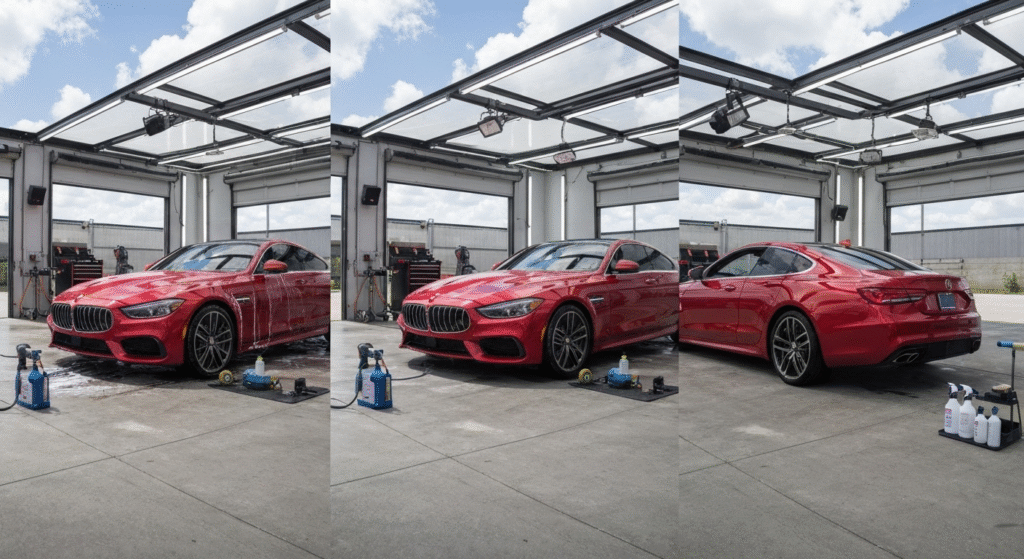
Ceramic Coating Installation
Professional ceramic coating installation takes 1-2 days for most vehicles. The process begins with thorough decontamination and paint correction.
Day one involves washing, clay bar treatment, and paint correction to remove swirl marks and scratches. This step is crucial because ceramic coating magnifies any imperfections in the paint.
Day two includes final cleaning and coating application. The coating goes on in thin, even layers using special applicators. Each section requires careful attention to prevent streaks or high spots.
PPF Installation Process
PPF installation takes 2-5 days depending on coverage area and vehicle complexity. Skilled technicians use computer-cut templates or hand-cut the film for perfect fit.
The installation process requires meticulous attention to detail. Each piece must align perfectly with body lines and curves. Squeegees and heat guns help conform the film to complex shapes.
Quality installers warranty their work and provide detailed care instructions for maintaining the film.
Maintenance Requirements
Caring for Ceramic Coating
Ceramic-coated vehicles need regular washing with pH-neutral soap. Avoid automatic car washes that use harsh chemicals or brushes that can damage the coating.
Monthly maintenance includes applying ceramic spray boosters to refresh the hydrophobic properties. Annual inspections help identify areas needing attention.
Avoid parking under trees or in areas with heavy bird activity when possible. Quick removal of contaminants prevents permanent staining.
Maintaining PPF
PPF requires minimal maintenance beyond regular washing. Use gentle soap and avoid high-pressure washing directly on film edges.
Inspect the film monthly for lifting edges or damage. Address issues quickly to prevent dirt infiltration or further damage.
Professional detailing every 6-12 months keeps PPF looking its best and extends its lifespan.
Real-World Performance Examples
During my five years in the industry, I’ve seen countless examples of both protection methods in action. One client’s ceramic-coated BMW stayed glossy and easy to clean through three Minnesota winters. The coating prevented road salt damage that would have required expensive paint correction.
Another client’s PPF-protected Porsche 911 survived a highway rock chip incident that would have cost $1,500 in paint repair. The film absorbed the impact and self-healed the minor scratch within hours.
A commercial fleet manager chose ceramic coating for 50 delivery vehicles. The easier cleaning process saved 30 minutes per vehicle during weekly washing, reducing labor costs significantly.
Cost-Benefit Analysis Over Time
5-Year Ceramic Coating Costs
- Initial application: $1,500
- Annual maintenance products: $100
- Total 5-year cost: $2,000
5-Year PPF Costs
- Initial installation: $4,000
- Minimal maintenance costs: $200
- Total 5-year cost: $4,200
However, PPF prevents paint damage that could cost thousands to repair. Ceramic coating reduces wash time and prevents environmental damage but won’t stop rock chips.
Common Mistakes to Avoid
Many car owners make costly mistakes when choosing paint protection. Skipping paint correction before ceramic coating application results in permanent imperfections. Always insist on proper paint preparation.
Choosing inexperienced installers leads to poor results with both options. Research installers carefully and check their work examples and customer reviews.
Expecting either option to make your car maintenance-free is unrealistic. Both require proper care and maintenance to perform optimally.
Future of Paint Protection Technology
New ceramic coating formulations promise longer durability and easier application. Graphene-enhanced coatings show improved performance in laboratory testing.
PPF technology continues advancing with better self-healing properties and improved clarity. Colored films expand customization options while maintaining protection.
Hybrid products combining ceramic and PPF technologies may offer simplified application with enhanced protection in the future.
Frequently Asked Questions
Can I apply ceramic coating over PPF? Yes, ceramic coating can be applied over PPF to provide additional hydrophobic properties and easier cleaning. This combination offers maximum protection and convenience.
How long does ceramic coating last compared to PPF? Ceramic coating typically lasts 2-5 years while high-quality PPF can protect for 5-10 years. PPF generally provides longer-lasting protection but costs more initially.
Which option provides better resale value protection? Both options help maintain your car’s appearance and resale value. PPF provides superior protection against permanent damage, while ceramic coating maintains gloss and prevents environmental damage.
Can I remove PPF myself? While PPF can be removed, professional removal is recommended to avoid paint damage. Improper removal techniques can leave adhesive residue or damage the clear coat underneath.
Conclusion
Choosing between ceramic coating and paint protection film depends on your specific needs, budget, and driving conditions. Ceramic coating offers easier maintenance and enhanced appearance at a lower cost. PPF provides superior physical protection and longer durability at a higher price point.
Consider your priorities carefully. If you want the best possible protection and can afford the investment, PPF delivers unmatched performance. For enhanced appearance and easier maintenance at a reasonable cost, ceramic coating is an excellent choice.
My experience has shown that both options significantly improve paint protection compared to leaving your car unprotected. The key is choosing the right solution for your situation and ensuring professional installation for the best results.
Remember that proper maintenance is essential for both options. Regular care extends the life of your investment and keeps your car looking its best for years to come.

